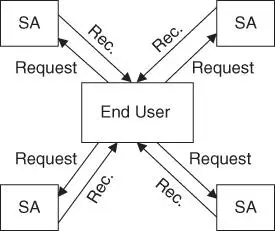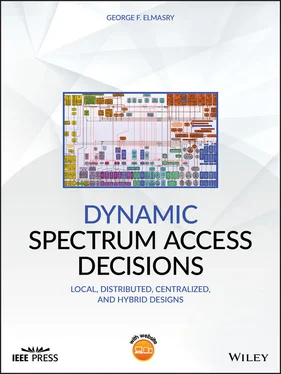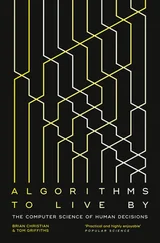
Figure 6.125G use of the macrocell as the fusion center.
This case can simply be described as a hybrid of distributed sensing and centralized fusion. Notice that this case can be morphed to the case where the SA, femtocells, and picocells perform a form of spectrum sensing information fusion and send the macrocell fusion center the results of its own local fusion. In either case, the macrocell fusion results are broadcasted to all lower hierarchy entities and the SA can't rely on its own local fusion results to respond to frequency band service requests from end users. Notice that even with the macrocell being the only place for fusion, the SAs, femtocells, and picocells perform a form of cooperative spectrum sensing.
If some SAs have limited energy and must conserve energy, the macrocell can select a subset of the SAs to perform spectrum sensing and collect sensing information. The macrocell algorithm has to consider the hidden node challenge discussed earlier in this book and select SAs that are geographically distributed to optimize sensing impact.
6.4.2 Spectrum Agents Operate Autonomously
With this case, SAs can share spectrum sensing information in a distributed manner along with their geolocation information if they are not publically known to be static. 19In this case, each SA is a fusion center of spectrum sensing information and the spectrum sensing information shared is abstracted as a spectrum map after fusion.
Figure 6.13points to a potential disadvantage of this approach as the SA working autonomously will require a control plan to be created to exchange the spectrum map information, as Figure 6.13shows. This control plan goes through the macrocell, which is supposed to have the most processing power and can act as the centralized fusion center.

Figure 6.13Autonomous SAs in a distributed cooperative fashion and their control place.
There are reasons for ensuring the SAs can operate autonomously. Consider the case of deploying 5G communications assets in a disaster area where there is no macrocell to reach out to. There is a need to ensure that dynamically deployed small cells with SA capabilities can perform DSM decisions autonomously, in addition to being access points. The deployed small cells will have spectrum sensing fusion capabilities and the means to share spectrum sensing information with other small cells to make DSM decisions independently of a large tower (macrocell).
6.4.3 The End User as its Own Arbitrator
One can conceptualize this case with very dense urban deployment where the end‐user device can obtain spectrum awareness information from multiple SAs and can use spectrum recommendations from multiple SAs to select the best spectrum band to operate on. Notice that if some QoS metrics are supplied to the end user as part of the recommendations, the end user can make the final decision on which band and which access point to select based on multiple factors, including least power consumption, highest data rate, and adhering to required QoS metrics thresholds.
Figure 6.14illustrates this case where the end user obtains four different recommendations of spectrum use from four different SAs. The end user makes the final local DSA decision on which recommendation it will use.

Figure 6.14The end use as the final arbitrator.
It is important to note that this case with the end user making the final arbitration decision does not exclude designing a system that uses the macrocell as the fusion center or a system that makes SAs work autonomously. The arbitration here is in the context of arbitrating between different recommendations from different SA points and considering other metrics such as QoS and rate while making the end user reach the final decision on which recommendation to use.
A service provider building a 5G infrastructure can build all the above capabilities in the deployed infrastructure and can enable or disable certain capabilities based on network management decisions or some cognitive algorithms that can morph the deployed infrastructure functionalities based on sensing information. One always needs to distinguish between capabilities or assets and how to use them dynamically. There are pros and cons for some capabilities that make them worth enabling only under certain conditions. For example, the case in Figure 6.14has the disadvantage of requiring the end‐user device to perform an arbitration decision, which is an extra processing requirement on a device with limited battery. However, in very dense urban deployment with the close proximity of multiple cells, the device is already not consuming too much power in maintaining links, making it possible for the device to use some power for arbitration decisions. Also, in the case of autonomous SAs, we have the challenge of having a sparse deployment where an SA would have to rely on limited spectrum sensing information sources, which can lead to encountering a hidden node. However, one can see that in disaster areas, creating autonomous 5G access points is urgent enough to overcome the impact of higher probability of hidden node interference.
5G standardization offers the service provider a lot of flexibility and different service providers will use different spectrum arbitration techniques or have some capabilities enabled or disabled based on network monitoring and management decisions.
6.5 Power Control, Orthogonality, and 5G Spectrum Utilization
So far, the models we used in Section 6.2 for spatial modeling and in Section 6.4for cooperative spectrum sensing are at a relatively abstracted level and have not considered other factors such as power control. One can consider that one of the 5G optimization goals is to maximize data rate for the least power consumption and spectrum energy emission in addition to the maximization of throughput in terms of bits per Hertz. The dense deployment of 5G cells allows the end‐user devices to achieve the desired data rate at low energy emission, but power control is still a critical factor in 5G DSM. In 5G, the policy given to a single end‐user device regarding power control has to be dependent on the policies given to other end users. The DSM technique would have to consider an equilibrium (e.g., a gamming theory based equilibrium) while using constraints in order to approach optimality of spectrum assignment at any given point in time.
One important tool 5G DSM can use before considering power control is signal orthogonality. Spectrum resources are mutually orthogonal blocks 20that can be cognitively utilized for data transmission to maximize data rate for the least power consumption and spectrum energy emission. Orthogonality is a critical tool in reducing SI.
With power control, Equations (6.3) and (6.4) are no longer enough to drive a model for SIR. Here, SIR encountered by a pair of transmitter and receiver nodes, k , has to consider the resource block n this pair is using. SIR can be expressed in the more general formula:
(6.5) 
Читать дальше
















